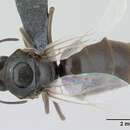Biology
provided by Arkive
This ant often builds its nest in soil, in tree stumps or under stones or logs, and it frequently nests beneath paving stones in gardens (4). It may occasionally invade the nests of other species of ants (1). Colonies number around 5, 500 individuals (1). A wide range of food is eaten, including seeds, flower nectar, flies and other small insects, which are killed and taken back to the nest. Small black ants also 'milk' aphids, collecting drops of sweet honeydew exuded by the aphids. Aphids may even be taken into the nest (2).
Winged reproductive males and females engage in a mass mating flight in hot, humid weather during July and August (2). Males die after mating, and females establish new colonies. A queen mates only once, storing sufficient sperm inside her body to last her lifetime. The mating flight ensures that the species disperses well, and also increases the chance that males and females from different nests will mate, avoiding inbreeding, as the winged reproductive adults of different colonies in one area fly at the same time (3). After finding a suitable location, the queen begins to produce eggs. The resulting 'workers' are non-reproductive females, who take over the care of the colony. After hatching, the larvae initially feed on unhatched eggs; they are then fed by the workers on a regurgitated fluid (3).
Conservation
provided by Arkive
No conservation action has been targeted at this species.
Description
provided by Arkive
This is the commonest ant seen in Britain. Workers (non-reproductive females) are blackish-brown in colour and covered in small hairs (2). Winged reproductive females (queens) are almost twice as big as the workers (3), are darker in colour and have a large pair of clear wings, which are shed after mating (2). Males also possess wings and are much smaller than queens (2). The larvae are legless grubs, and the pupae are protected inside a white silk cocoon (3).
Habitat
provided by Arkive
Although found in a wide range of habitats, this ant is perhaps most familiar as a garden species (4). It also occurs in scrubland and wet areas. It can only survive in grasslands providing that there are either stones or mounds of the yellow meadow ant (Lasius flavus) present (1).
Range
provided by Arkive
The small black ant is found throughout Europe, and also occurs in Japan and North Africa. In the UK, this species has a broad distribution, but is absent from certain areas of Scotland (1).
Status
provided by Arkive
Widespread and very common (1).
Threats
provided by Arkive
This ant is not currently threatened.

